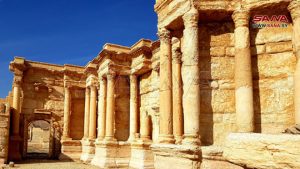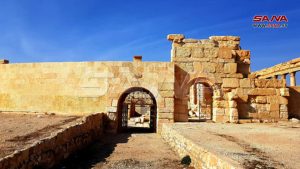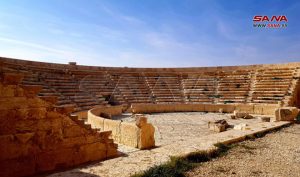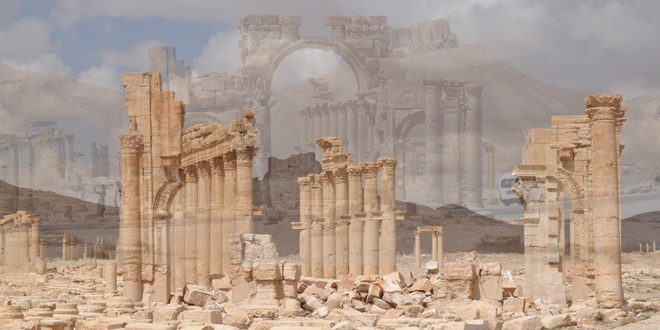The city of Palmyra is one of distinguished sites inscribed on the UNESCO World Heritage List, where its ruins are witness to the greatness of this city, which was one of the most important cultural and commercial centers in the ancient world, specifically on the Silk Road.
Palmyra, known as the “Pearl of the Desert” and the oasis of ancient times was and still, with its charm, prestige and mystery, one of the most attractive archaeological sites for tourists, inspiration of poets and archaeologists, as well as place for commercial caravans .
It is famous and characterized by its stunning temples, unique tombs and streets full of huge colmuns.
Archaeologist, Dr. Khalil Hariri said “the name of the Silk Road was given to the road connecting China and Rome by the German traveler Ferdinand von Richthofen in 1860, during his many journeys to the regions of the East as a result of the historical, scientific, cultural and economic importance of silk.”
 The city of Palmyra’s distinguished location in the middle of Badiyat Al-Sham connecting the road between the cities of the Euphrates Basin to the east and the cities of the Syrian coast to the west, made the Silk Road the shortest distance, the best crossing and the most secure and peaceful for commercial caravans, with the important artifacts and valuables they carry , in addition to cotton and woolen textiles, purple, glass, perfumes, and incense. spices and oils.
The city of Palmyra’s distinguished location in the middle of Badiyat Al-Sham connecting the road between the cities of the Euphrates Basin to the east and the cities of the Syrian coast to the west, made the Silk Road the shortest distance, the best crossing and the most secure and peaceful for commercial caravans, with the important artifacts and valuables they carry , in addition to cotton and woolen textiles, purple, glass, perfumes, and incense. spices and oils.
Al-Hariri added: “The diversity of cultures in Palmyra is an inevitable result of Palmyra’s site among different cultures, indicating the Palmyrene have excelled in preparing a caravan system for passing long distances and facilitating its passage.
He said that the “Agora” in Palmyra ( the “public market”) was a center for cultural, trade and a meeting place as the economic prosperity resulting from trade and the passage of the Silk Road in Palmyra made it the capital of wealth, luxury, peace and dreams, and contributed to its urban, artistic, cultural and social progress.
In turn , the tourist guide Musa Fleih said “Palmyra was not immersed in history despite its remoteness Deep in the Syrian desert, it was mentioned in the annals of the Assyrian king Tflat-pileser, who lived in the 11th century BC. It has always been a mystery and a source of inspiration for writers, adventurers and tourists.
French researcher Georges Tat says in his book “Palmyra, the Desert Gun”: “Palmyra, since it was recognized by English merchants who were coming from Aleppo, and after knowing its language and translating its texts, it became seen as a fictional city because of its monuments that appeared in the middle of the desert, such as a mirage or Puzzle”.
 Concerning Zenobia, the Queen of Palmyra, who was the heir of two civilizations, Fleih indicated that Zenobia was the daughter of a merchant from Palmyra and a Greek mother. She spoke Aramaic, Coptic, Latin and Greek, and enjoyed the policy wisdom, reason and politics.
Concerning Zenobia, the Queen of Palmyra, who was the heir of two civilizations, Fleih indicated that Zenobia was the daughter of a merchant from Palmyra and a Greek mother. She spoke Aramaic, Coptic, Latin and Greek, and enjoyed the policy wisdom, reason and politics.
She imitated the kings of Akasara and the Roman emperors. Palmyra and its noble and courageous queen in the Western world after the Renaissance became a captivating legend.
Archaeologist Muhammad Khaled Al-Asaad recalled the last words uttered by his father, the martyr archaeologist Khaled Al-Asaad, “The palm trees of Palmyra do not bend”.
The late archaeologist was killed by terrorists groups on August 18, 2015, in the lobby of the Palmyra National Museum, the place that he loved for more than Half a century, where he went down in the museum yard , barefoot, chained, unafraid of death.
Muhammad al-Asaad said during a cultural event organized by the Ornina Cultural Forum in cooperation with the Holy Spirit Cathedral in Old Homs: “If the great Palmyra in the days of its splendor and glory was the gift of the world to human civilization, then its righteous son Khaled al-Asaad is a gift of Palmyra to human culture.”
 The late archaeologist Khaled Al-Asaad was the head of the Department of Antiquities and Museums in Palmyra between 1964- 2003 during which he worked with his Arab and foreign colleagues to develop the archaeological institution operating in Palmyra scientifically and administratively to preserve the archaeological site of Palmyra, highlight its features, restore it, and introduce it in a civilized manner.
The late archaeologist Khaled Al-Asaad was the head of the Department of Antiquities and Museums in Palmyra between 1964- 2003 during which he worked with his Arab and foreign colleagues to develop the archaeological institution operating in Palmyra scientifically and administratively to preserve the archaeological site of Palmyra, highlight its features, restore it, and introduce it in a civilized manner.
He worked on publishing archaeological and historical research on Palmyra site and managed to explore every sculpture, drawing or inscription, and was able to highlight the intellectual richness and spiritual loftiness of the ancient Palmyrene.
It is noteworthy that the United Nations Educational, Scientific and Cultural Organization (UNESCO) had inscribed Palmyra on the World Heritage List among six sites on the main list in Syria, all of which were classified under the cultural category.
Rawaa Ghanam

